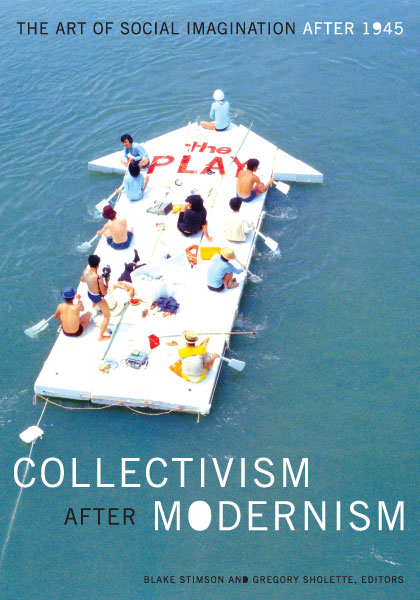Blake Stimson, Gregory Sholette (eds.): Collectivism after Modernism: The Art of Social Imagination after 1945 (2007)
Filed under book | Tags: · collaboration, collective art, participation, situationists, video art

“The desire to speak in a collective voice has long fueled social imagination and artistic production. Prior to the Second World War, artists understood collectivization as an expression of the promise or failure of industrial and political modernity envisioned as a mass phenomenon. After the war, artists moved beyond the old ideal of progress by tying the radicalism of their political dreams to the free play of differences.
Organized around a series of case studies spanning the globe from Europe, Japan, and the United States to Africa, Cuba, and Mexico, Collectivism after Modernism covers such renowned collectives as the Guerrilla Girls and the Yes Men, as well as lesser-known groups. Contributors explore the ways in which collectives function within cultural norms, social conventions, and corporate or state-sanctioned art. They examine the impact of new technologies on artistic practice, the emergence of networked group identity, and the common characteristic of collective production to blur the typical separations between artists, activists, service workers, and communities in need.
Together, these essays demonstrate that collectivism survives as an influential and increasingly visible artistic practice despite the art world’s star system of individuality. Collectivism after Modernism provides the historical understanding necessary for thinking through postmodern collective practice, now and into the future.”
Contributors: Irina Aristarkhova, Jesse Drew, Okwui Enwezor, Rubén Gallo, Chris Gilbert, Brian Holmes, Alan Moore, Jelena Stojanovi´c, Reiko Tomii, Rachel Weiss.
Publisher University of Minnesota Press, 2007
ISBN 0816644624, 9780816644629
xviii+312 pages
Key terms: Art & Language, collectivism, unitary urbanism, Akasegawa Genpei, video art, detournement, conceptual art, Asger Jorn, Fluxus, ABTV, Ernesto Leal, Situationist International, Guy Debord, Havana, Glexis Novoa, cold war, Art Workers Coalition, avant-garde, Cuba, Gutai
PDF (9 MB, updated on 2019-12-18)
Comments (2)Craig J. Saper: Networked Art (2001)
Filed under book | Tags: · art, bureaucracy, conceptual art, concrete poetry, fluxus, lettrism, mail art, network culture, networks, poetry, visual poetry

“Outlines an exciting new approach to this confluence of art, media, and poetry.
The experimental art and poetry of the last half of the twentieth century offers a glimpse of the emerging networked culture that electronic devices will make omnipresent. Craig J. Saper demarcates this new genre of networked art, which uses the trappings of bureaucratic systems—money, logos, corporate names, stamps—to create intimate situations among the participants.
In Saper’s analysis, the pleasures that these aesthetic situations afford include shared special knowledge or new language among small groups of participants. Functioning as artworks in themselves, these temporary institutional structures—etworks, publications, and collective works—give rise to a gift-exchange community as an alternative economy and social system. Saper explains how this genre developed from post-World War II conceptual art, including periodicals as artworks in themselves; lettrist, concrete, and process poetry; Bauhaus versus COBRA; Fluxus publications, kits, and machines; mail art and on-sendings. The encyclopedic scope of the book includes discussions of artists from J. Beuys to J. S. G. Boggs, and Bauhaus’s Max Bill to Anna Freud Banana. Networked Art is an essential guide to the digital artists and networks of the emerging future.”
Key words and phrases: Fluxus, concrete poetry, mail art, mail artists, visual poetry, Dick Higgins, Big Dada, conceptual art, Ray Johnson, George Maciunas, sound poetry, Ken Friedman, Guy Bleus, Bauhaus, detournement, neoist, Max Bill, Augusto de Campos, George Brecht, Joseph Beuys
Publisher University of Minnesota Press, 2001
ISBN 0816637075, 9780816637072
198 pages
PDF, PDF (updated on 2018-9-21)
Comments (3)Kynaston L. McShine (ed.): Information (1970)
Filed under catalogue | Tags: · art, conceptual art, institutional critique

Catalogue for an exhibition curated by Kynaston McShine and held at MoMA in New York between 2 July-20 September 1970.
The exhibition presented videos and installations by 100 American and European artists (e.g. Vito Acconci, Art & Language, Daniel Buren, Jan Dibbets, Hans Haacke, Dennis Oppenheim, Edward Ruscha, Robert Smithson, or Jeff Wall). It included an early example of dealing with publicly accessible archives within the context of an exhibition and some of the participating artists confronted the issues of political and media based contents: Haacke established MoMA Poll as a first link between the areas of politics and the museum by presenting an open poll on the way the Rockefeller family acted with regard to Nixon’s plans in Indochina.
Publisher Museum of Modern Art, New York, 1970
207 pages
via MoMA
Commentary: Eve Meltzer (Oxford Art Journal, 2006), Interviews with Adrian Piper and Hans Haacke (Doreen Mende, Displayer, 2007), Adam Lauder (2010).
PDF (52 MB)
Comments (2)
